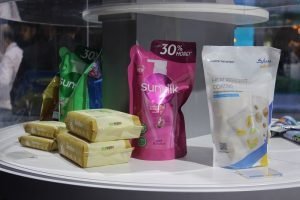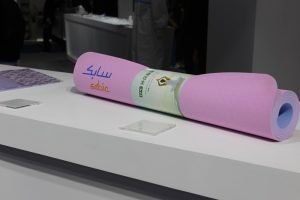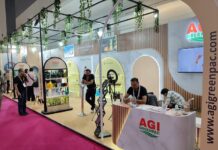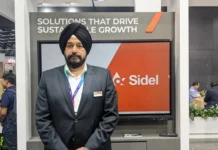According to a Grand View Research report, the global plastic packaging market is expected to reach US$ 269.6 billion (approximately Rs 24,37,948 crore) in 2025. This meets with a growing demand for flexible as well as rigid functional, food, non-food, and beverage packaging products to serve an increasingly urban population, worldwide. Sabic aims to help the packaging industry in solving the challenges of these needs with an advanced portfolio of materials designed to minimize the environmental impact of packaging, increase recyclability, extend shelf-life and prevent food losses, provide supply security, and create sustainable growth.
“One thing people realized during the pandemic and the ensuing lockdowns is that we needed longer shelf life. We needed packaging to enable the nutrients of the food to stick around for a longer period. That is one of the areas where the right packaging and sustainable solutions are practically playing a very important role,” said Bhaskar Pratham, senior manager of T&I Global Application Technology, Predictive Engineering & Design at Sabic. Food safety continues to be a very important aspect and our packaging solutions can play a very important role by increasing the strip shelf life and reducing wastage, he added.
The company’s products for the flexible packaging industry include polyethylene materials, HPPE, LLDPE, LDPE, and more specialized resins such as polyolefins and elastomers and polyolefin plastomers for enhanced sealing. It also has solutions to make its material use cases sustainable. “These could include monomaterial solutions that involve biaxially-oriented or machine direction-oriented materials that can then go into the monomaterial packaging that is more amenable to recycling. That becomes a very important part of our sustainable footprint,” says Patham.

Sabic’s TruCircle portfolio and services include circular-certified polymers based on a mass balance accounting approach according to ISCC PLUS, validating the feedstock content produced by advanced chemical recycling of mixed plastic waste. Sabic’s TruCircle portfolio includes solutions for mechanical recycling, chemical recycling, and renewable feedstock.
The examples at PlastIndia were heat-resistant mono-PE pouches developed in collaboration with Covestro; retort pouches for wet pet food developed in collaboration with Mars Petcare and Huhtamaki for Mars’ Sheba brand; and, adhesive packaging labels from ocean-bound plastics developed in collaboration with UPM Raflatac and Taghleef Industries. Orkla’s chips bags packaging developed with Sabic’s certified renewable polypropylene (PP) polymer and multi-layer bottles from W Müller using its certified renewable HDPE polymer were other examples exhibited at the recent PlastIndia in New Delhi from 1 – 5 February 2023.
Sabic promoted its BX202 BOPE, PP 5212P, LDPE 7019EC, and Cohere S100 (L) products at PlastIndia apart from the TruCircle portfolio. According to Patham, Sabic’s success is the success of its customers. “The partnership with the value chain and our customers – this engagement is what energizes us and energizes our innovation,” Patham added. “In terms of how Sabic engages and aspires to engage with the packaging industry is to not be just a resin supplier, we want to work with the convertors, laminators, end users, and brand owners to make sure we can flow more sustainable solutions into the market.
“For example, oriented films for monomaterial solutions is an important area where we want to play into sustainable or recyclable solutions. Packaging happens to be an extremely important industry as a whole and we bring in greater sustainability, better mechanical properties, and more efficient material in these solutions.”
Technology & Innovation
“The biggest USP of our product portfolio is its breadth – we have solutions that range from polyolefin materials such as polyethylene, polypropylene to a portfolio of engineering thermoplastics such as polycarbonates, polybutylene terephthalates, reinforced materials, short glass filled, long glass-filled polypropylenes, and a portfolio of more specialized materials like polyphenylene oxide.”
The breadth of the product portfolio allows Sabic to address a very broad range of markets – from flexible and rigid packaging, caps and closures, foams, pipes, and automotive to aerospace, health care, and hygiene. “Its internal ‘Within our Technology and Innovation Organization’ (Within our T&I ) works closely with its market-facing teams and is geared towards the full value chain for bringing complete solutions to the market.

“We are not just resin suppliers, we are constantly wearing the hats of the converter, the brand owner, and the producer to understand how can we help them. We invest a lot both in processing and performance testing and creating sustainable solutions so that we can then take these solutions out to our customers,” he said.
Sabic’s Indian Operations
Sabic’s technology and innovation center in Bengaluru addresses both chemicals and polymers. Within the center are its agri-nutrients, high-performance polymers, petrochemicals divisions and enabling divisions for sustainability, digitalization, process modeling, and the corporate, T&I, and analytical teams.
The center engages in application development, material modeling, predictive engineering and simulations, application processing (IM), and testing.“Bengaluru can become a hub for innovations and translations in the region– in the Indian subcontinent and in South and Southeast Asia,” suggests Patham.
“Some of the recent innovative work that we are doing from a polymers’ perspective is coming up with solutions for renewable energy for the packaging around silicon. We are also working on our TruCircle solutions in India whether it be mechanical recycling or chemical recycling. Another important area for India that is growing is the energy transition to electrification whether it is the automobile, two-wheeler, or stationary storage. We are coming up with solutions to make these solutions more lightweight, more functionally integrated and our flame retardant resins to make the applications safe and robust,” he said.
In addition to the technology center, Sabic has a compounding plant in Vadodara. With the Indian headquarters in Gurgaon, its sales and marketing teams are spread out across the country close to its customers.
Sustainability at its core
Sustainability is an essential pillar of Sabic. It is not something nice to have, it is at the core of what we do, Patham pointed out. “If you look at how Sabic evolved as a company, its basis is in sustainability. For example, when it was decided that the gasses that come along with petroleum mining would be utilized for the production of petrochemicals that was the basis of the formation of this company.
Our foundation is based on sustainability, starting from how we are offering our products, creating our solutions, and playing in the application space. Recyclability, circularity, or carbon neutrality become an important part of our plants and manufacturing facilities and wherever we are a part of the value chain, how can we reduce the carbon footprint,” he said. An example is the Microsoft mouse made out of ocean plastics – one way of creating awareness of what is possible to make these applications sustainable.
Design for recyclability and design for reuse are two important themes for sustainable packaging. “In terms of monomaterials, there is a trend in both flexible packaging and rigid packaging. In flexible packaging, for example, how can you make an all-polyethylene solution or all single material solution while at the same time retaining the barrier properties and food contact safety? In the case of rigid packaging solutions, we are looking at caps and closures to make the cap and the bottle of the same material so that recycling becomes easier,” he explained.
“If you look at Sabic in India, I see this as an optimistic growth story. The portfolio that is relevant to India increases because of several new developments, and at the same time, India grows in areas such as renewable energy, and automotive electrification which are very important trends for the overall growth of the country. In that sense, Sabic would love to partner with the region in how we can promote growth through our materials and solutions. The presence of our innovation hub in Bangalore also becomes important to test these solutions, work with our customers and create opportunities that reach the market,” he concludes.
IndiFoodBev — authentic, impactful and influential
An English-language food and beverage processing and packaging industry B2B platform in print and web, IndiFoodBev is in its third year of publication. It is said that the Indian food and beverage industries represent approximately US$ 900 billion in revenues which implies more than 20% of the country’s GDP. Eliminating the wastage on the farmside can help to deliver more protein to a higher number of the population apart from generating sizable exports. The savings in soil, seeds, water, fertilizer, energy and ultimately food and nutrition could be the most immense contribution that country is poised to make to the moderation of climate change.
To improve your marketing and grow sales to the food and beverage processing and packaging industry, talk to us. Our research and consulting company IppStar [www.ippstar.org] can assess your potential and addressable markets in light of the competition. We can discuss marketing, communication, and sales strategies for market entry and growth.
Suppliers and service providers with a strategy and budget for targeted marketing can discuss using our hybrid print, web, video, and social media channels to create brand recognition linked to market relevance. Our technical writers are ready to meet you and your customers for content.
The second largest producer of fruit and vegetables in the world is continuously expanding processing capacities and delivery systems with appropriate innovative technologies. We cover product and consumer trends, nutrition, processing, research, equipment and packaging from farm to thali. Get our 2025 media kit and recalibrate your role in this dynamic market. Enhance your visibility and relevance to existing markets and turn potential customers into conversations. Ask for a sample copy of our bi-monthly in print or our weekly IndiFoodBev eZine each Wednesday.
For editorial info@ippgroup.in — for advertisement ads1@ippgroup.in and for subscriptions subscription@ippgroup.in
Naresh Khanna – 10 February 2025
Subscribe Now











